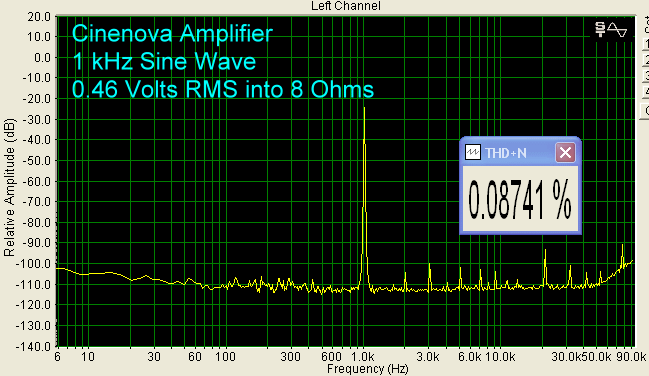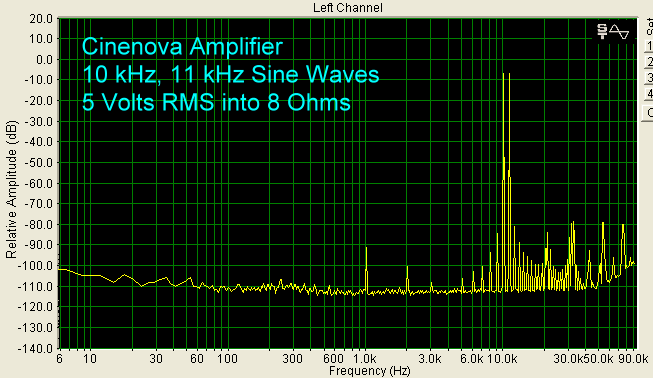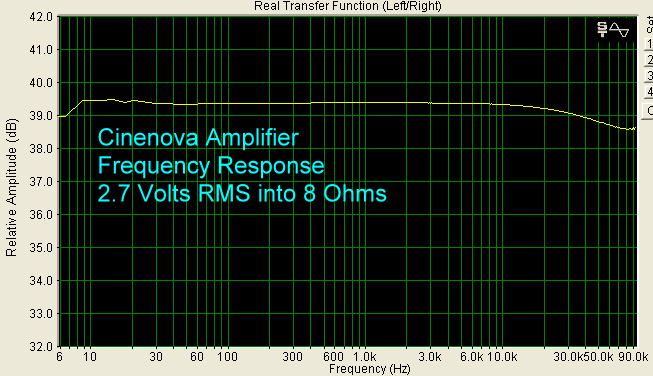|
||||||
|
On the Bench For the bench tests, I used the XLR input. I measured a maximum of 338 watts RMS into 8 ohms output with two channels being driven, with THD+N being 0.88%. This is a very powerful amplifier, and I was not able to test it with all seven channels driven at the same time. As it was, the power resistors were practically smoking. However, I note that this value is just about the same as that reported by another publication with all seven channels driven. The 4 kVa power supply toroidal transformer seems to deliver more than enough voltage to the individual modules such that the output is only limited by the maximum rail voltage that is supplied, rather than limited by too small of a transformer or not enough capacitance. At 1 kHz, and 5 volts output, THD+N was 0.01%. Signal to noise at 5 volts and 1 kHz was 101 dB. Excellent!
At less than 1/2 volt output, THD+N was still less than 0.1%. Low THD at low volume is critical for listening during quiet musical passages.
For 1 kHz and 1.5 kHz sine wave signals, the A+B IMD peak at 2.5 kHz was 88 dB below the fundamental, while the B-A peak at 500 Hz was 85 dB below.
IMD for 5 kHz and 6 kHz fundamental test frequencies was also low, with the A+B peak at 11 kHz at - 79 dB, and the B-A peak at - 84 dB.
For 10 kHz, THD+N was less than 0.05%, a very good figure.
IMD tests, using 10 kHz and 11 kHz sine wave signals, gave an A+B peak at - 77 dB, and the B-A peak at 1 kHz at - 84 dB.
Plotting THD+N vs. Power Output (watts RMS into 8 ohms or 4 ohms), you can see that distortion is higher at low output, then bottoms out at 30 watts at 8 ohms and 50 watts at 4 ohms, then increases slowly to about 250 watts at 8 ohms and 500 watts at 4 ohms, before increasing rapidly to the clipping point (1% THD+N) at 340 watts output at 8 ohms and 600 watts output at 4 ohms. At a typical listening level of 1 to 10 watts output, distortion stays below 0.05%.
The measured frequency response was improved over the version we tested in 2004, now being ± 0.5 dB 10 Hz - 90 kHz. Check out the basic response of the earlier unit, plus the response with the crossover activated. This would be a great feature for bi-amping purposes.
Testing out to 200 kHz shows that the frequency response rolls off substantially above 150 kHz. I also wanted to confirm the + 0.2 dB bump between 25 Hz and 10 Hz, using a different test instrument (Audio Precision), and it was indeed there. Usually, the low end rolls off in an amplifier. This essentially flat response all the way down to 10 Hz is partly responsible for the great bass that the Cinénova has.
Conclusions It was great back in 2004, and it is great+ in 2006 with its improved frequency response. Having some of the best bass output I have ever heard in a power amplifier, the Cinénova Grande is a KILLER!
- John E. Johnson, Jr. -
|
||||||












